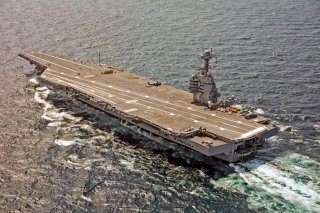The USS Gerald Ford Aircraft Carrier Is More Ready than Ever
The breakthroughs are significant.
Here's What You Need to Remember: The Ford is also built with a new generation of computing, electronics, and onboard power-generation capacity. This enables a much greater degree of computer automation with increased efficiency and also allows for a sizable reduction in crew size.
The Navy’s USS Gerald R. Ford aircraft carrier may be prepared to survive ocean bombing attacks, depending upon how it performed in its first scheduled “explosive event” on the Atlantic Ocean for Full Shock Trials, a process intended to ensure the ship is ready for massive, high-end combat on the open ocean.
Various kinds of bombs, missiles, and other weapons are used to attack the Ford and the surrounding ocean to assess the ship’s ability to stay afloat while under enemy fire. The process is a vital step for the first-in-class ship as it prepares for its upcoming maiden deployment in the next several years. Despite years of delays, cost overruns, and technical development hurdles, the ship will, it is safe to say, usher in a new era of maritime warfare for the U.S. Navy.
Certainly, many lessons were learned throughout the developmental process and then subsequently applied to follow-on Ford carriers now under construction, and it seems all of the innovations and breakthrough technologies are either operational or in the final stages of war preparations. Some were critical of Navy developers regarding the USS Ford, claiming it may have simply been too ambitious to attempt to integrate so many new technologies onto a ship at once. However, there are several key things to consider. First, the ship is now a success with the arrival of its electric weapons elevators finishing up and its breakthrough technologies all operational. Secondly, while certainly ambitious, one could easily make an argument that a collection of breakthrough technologies were needed to meet the anticipated future threat environment.
The breakthroughs are significant. The ship can now successfully operate with an Electromagnetic Catapult which is not only scalable but also capable of generating a smoother, less “shot-gun” like take-off thrust. This not only improves mission reliability but also decreases wear and tear upon the aircraft. It also supports the massively upticked attack tempo possibilities developers wanted to build into the Ford. The sortie rate is already considerably higher than Nimitz-class carriers as the deck space is much larger, enabling a 33-percent increase in sorties.
This means an enemy target area can be blanketed, overwhelmed, and simply blitzed with a series of massive, high-op-tempo air attacks, one right after another.
The Ford is also built with a new generation of computing, electronics, and onboard power-generation capacity. This enables a much greater degree of computer automation with increased efficiency and also allows for a sizable reduction in crew size. The ship is also built with a new generation of Arrested Landing Gear to improve the carrier landing process.
There is yet another key factor to consider, meaning that carriers are increasingly likely to function in a more independent fashion or more semi-autonomously apart from Carrier Strike Groups to support more dispersed, disaggregated operations aligned with the service’s Distributed Maritime Operations strategy. What this amounts to is that carriers are themselves being increasingly armed with new ship defenses and weapons to prepare for the prospect of more substantial warfare engagements. The additional onboard power capacity could also support newer weapons systems such as lasers, which are already arming surface ships.
Kris Osborn is the defense editor for the National Interest. Osborn previously served at the Pentagon as a Highly Qualified Expert with the Office of the Assistant Secretary of the Army—Acquisition, Logistics & Technology. Osborn has also worked as an anchor and on-air military specialist at national TV networks. He has appeared as a guest military expert on Fox News, MSNBC, The Military Channel, and The History Channel. He also has a Master’s Degree in Comparative Literature from Columbia University.
This article is being reprinted for reader interest.
Image: Flickr.

